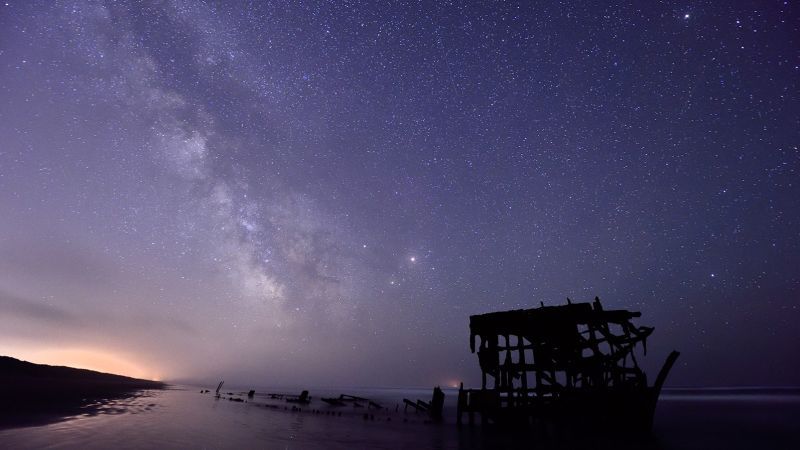See a meteor shower and lunar eclipse this weekend
Sign up for CNN’s Wonder Theory science newsletter. Explore the universe with news on fascinating discoveries, scientific advancements and more.
CNN —
With bright meteors blazing across the sky from the Aquariids meteor shower and a chance to see a lunar eclipse, Friday will be the time to look up to the sky for a day of spectacular celestial events.
Anyone venturing out to spot a meteor with this year’s Aquariids show could see up to 20 meteors per hour, but you’ll have to be up early — the best times to try to see a meteor will be just before dawn on Friday, Saturday or Sunday. The event’s estimated peak time is at 11 a.m. ET Saturday.
Alongside the shower comes the May flower moon, the first full moon of the “month of flower,” and its almost perfect alignment with the sun and Earth. That alignment will create what is known as a penumbral lunar eclipse, which is when the moon enters Earth’s outer shadow. This event will be between 11:13 a.m. and 3:31 p.m. ET Friday but won’t be visible in the Americas because the moon isn’t up then. But it will cause a dimming of the lunar surface for those in Africa, Asia and Australia.
The collision of celestial events might be exciting for space enthusiasts, but together they could hinder your view. With the moon completely full, the Aquariids will have to compete with some bright light interference to be seen in the night sky.
“I would suggest going out around 3 o’clock in the morning. Get a lawn chair and put the moon at your back,” said Robert Lunsford, fireball report coordinator for the American Meteor Society. “Look for these fast meteors shooting upward from the eastern horizon. Not all meteors you see will be Eta Aquariids, but they’re easy to tell because the Eta Aquariids are very fast.”
More on the lunar eclipse
During an eclipse, the shadow Earth casts is broken up into two sections: the umbra, which is the dark center, and the penumbra, the fainter outer shadow. During a penumbral eclipse, the moon stays on this outer ring, appearing as if it is dimming, but not completely darkening like a total lunar eclipse.
“The moon passes through the portion of the Earth’s shadow, and because it grazes the shadow it’s not quite as much distance as when it passes through the entire shadow of the Earth,” said Noah Petro, chief of NASA’s Planetary Geology, Geophysics and Geochemistry Lab, noting that it will be hard for someone to see. “The dimming of the moon is very slight, but if someone is in a dark place, they may notice the full moon is not quite as bright as normal.”
Still, Petro encouraged people in Asia and Australia to get out and see the lunar eclipse.
“Any chance people have to get out and look at the moon is an excellent opportunity to connect with our moon. Eclipses (penumbral or total) are great excuses to take a look at the moon and start looking at it more regularly!”
More on the Eta Aquariids
Every annual meteor shower has a radiant, the constellation from which the meteors appear to be originating. The Aquariids constellation is Aquarius, hence the shower’s name, and lies on the ecliptic, the sun’s path in the sky.
The Aquariids are only visible just before dawn since the radiant rises a few hours before the sun does, limiting the evening hours in which you can see them.
Those in northern areas, such as Canada, will have a smaller window to see activity, the American Meteor Society’s Lunsford said, while those in the Southern Hemisphere will have a slightly longer time frame where the radiant will be up, and the sun will still be down.
The Aquariids typically produce meteors that are faster than others, including the last event of the Lyrids in April, which means they tend to produce more persistent trains, smoke trails caused by disintegration of the blazing fast meteors. A meteor’s speed is determined by the angle in which it encounters Earth, with the Aquariids mostly colliding with the atmosphere head-on, Lunsford said.
Lunsford also mentioned that this year’s peak is expected to see slightly more meteors per hour, and next year even more so due to perturbation that has caused the debris trail to move closer to Earth. In 2024, Lunsford estimates that those within the Southern Tropics could see a range of 75 to 100 meteors per hour.
“You don’t need expensive equipment; it is a way that you can participate in astronomy without spending a lot of money, and it’s fun,” Lunsford said. “You can actually make useful scientific contributions by counting the number of meteors you see and trying to separate them into Lyrids or non-Lyrids.
“Besides, it’s like having an early Fourth of July celebration … to see a shooting star. And, who knows, you can make a whole lot of wishes if you see a bunch.”
More meteor showers to come
The Eta Aquariids will be hanging around until May 27, but if you missed their peak, there are plenty more opportunities to spot a meteor.
Here are the remaining meteor showers of 2023 and their peak dates:
• Southern Delta Aquariids: July 30-31
• Alpha Capricornids: July 30-31
• Perseids: August 12-13
• Orionids: October 20-21
• Southern Taurids: November 4-5
• Northern Taurids: November 11-12
• Leonids: November 17-18
• Geminids: December 13-14
• Ursids: December 21-22
Solar and lunar eclipses
The penumbral lunar eclipse event is only viewable to those in certain parts of the world, but there are other chances to see an eclipse in your area:
If you live in North, Central or South America, an annular solar eclipse will take place on October 14, when the moon moves in front of the Earth’s view of the sun, creating a crisp, fiery circle in the sky.
On October 28, a partial lunar eclipse will be viewable in Europe, Asia, Australia, Africa, parts of North America and much of South America.
More full moons
This year will have 13 full moons, with two in August. Here’s the list of full moons remaining in 2023, according to the Farmers’ Almanac:
• June 3: Strawberry moon
• July 3: Buck moon
• August 1: Sturgeon moon
• August 30: Blue moon
• September 29: Harvest moon
• October 28: Hunter’s moon
• November 27: Beaver moon
• December 26: Cold moon
Source: CNN


